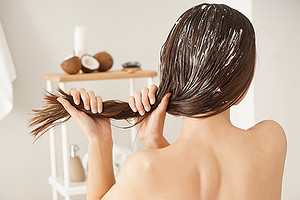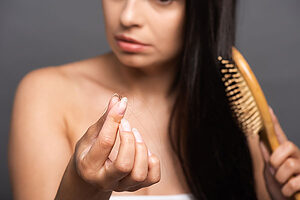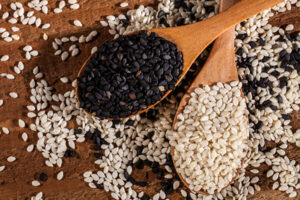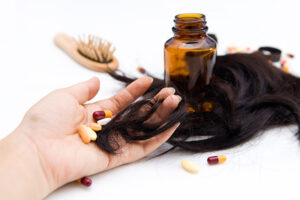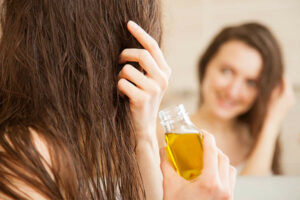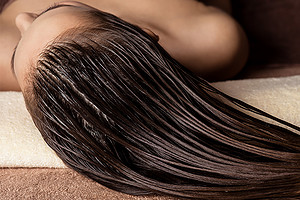Hair is cherished as the most essential part of the human body. However, to achieve beautiful hair, people often do things that damage the hair.
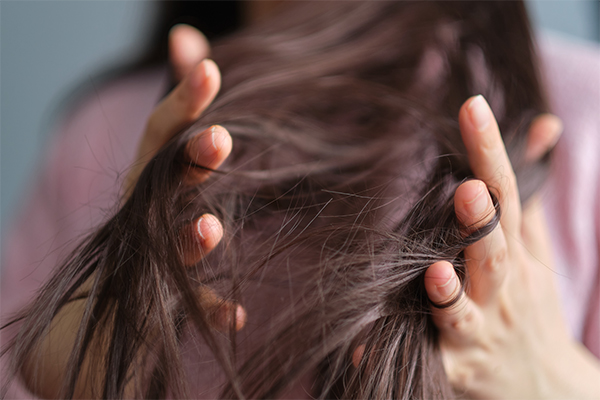
Damaged hair is fragile, leading to hair breakage, frizziness, and unhealthy-looking hair, and if you continue doing damaging hair practices, you may end up with bald spots and thin hair. (1)
There are several reasons for hair damage, such as environmental issues, underlying health issues, grooming habits, and daily hair care practices that make the hair weak, fragile, and damaged. (2)
Extensive hair damage can lead to hair problems such as hair loss (16%–96%) and breakage, and these can worsen if proper care is not taken. (3)
Therefore, to give your hair the proper care and to avoid such problems, you must first know the types of hair damage. Read on to find out more.
Article Contents
Different Types of Hair Damage and How to Avoid It
The following are the types of hair damage.
1. Heat styling damage
For hair styling, hair is treated at high temperatures (up to 200°C) with external stress (human hand), such as permanent hair curling, straightening, and waving. (5)
Straight styling at high temperatures has become a part of the everyday routine of many people and leads to significant damage to hair keratin fiber. (6)
How to avoid heat styling hair damage:
- Apply a heat protectant before using styling rods.
- Don’t subject your hair to heat for long periods.
- Try a no-heat hairstyle instead.
- Set your heat styling tools to the right temperature when in use.
2. Chemical damage
Peroxide chemical treatments can easily reach the hair cortex and cause intended melanin reduction but also unintended oxidative damage to the hair fibers. When peroxide enters hair fibers, it significantly damages the protective layer of the hair’s outer surface. (8)
Exposure to chemical cosmetics (such as hair bleaching, perming, hair straightening, and dyeing) and unhealthy grooming habits can weaken the hair fibers and are the primary causes of hair damage. (9)(10)(11)
How to avoid chemical hair damage:
- Steer clear of hair bleaching, and use sulfate-free, low-pH shampoo. (11)
- Go for deep-conditioning hair treatments, such as hot oil treatments, to condition your hair deeply and avoid dryness and dullness.
- Drink plenty of fluids to keep your hair hydrated.
3. Mechanical damage
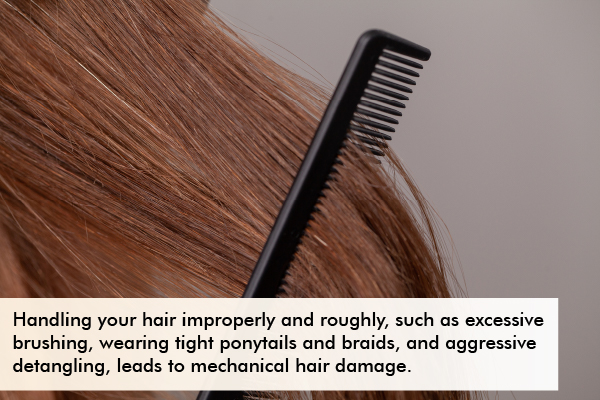
Handling your hair improperly and roughly, such as excessive brushing, wearing tight ponytails and braids, aggressive detangling, and using weaves, leads to mechanical hair damage. Other factors include hair bleaching and straightening.
Mechanical damage appears as mid-shaft splits due to excessive breakage. (10)(12)
How to avoid mechanical hair damage:
- Practice hair oiling (especially using coconut oil), which is a hair massage common among Indian women, to prevent hair damage. (13)
- Use a wide-toothed comb with rounded tips and slowly comb through your hair to avoid unwanted tension and breakage. (14)
- Avoid towel rubbing as it causes friction; doing it excessively can damage and break your hair. (11)
- Apply a hair mask to repair, nourish, and hydrate your hair and make it soft, healthy, and strong.
4. Hard water damage
Hard water increases hair breakage by decreasing strength. The magnesium sulfate and calcium carbonate in water result in temporary and permanent hardness.
Hard water is considered bad for the hair, as per a recent research study, when hair was washed with hard water and deionized water, it decreased hair strength. (3)
Hard water is the primary cause of hair weakening (not hair loss) and breakage. (15)
How to avoid hard water hair damage:
- Wash your hair with vinegar to remove mineral buildup. It also smoothens the hair cuticles and balances hair pH, leaving the hair soft and fresh.
- For the final hair wash, use bottled water.
5. Sun damage
Excessive sun exposure leads to structural damage to the hair shaft. Photochemical impairment results in protein loss and hair pigment degradation. Hair protein degradation is instigated by 254–400 nm wavelengths.
UVA radiation changes the hair color and damages hair, and UVB radiation causes hair protein loss. (16)
How to avoid sun hair damage:
- Minimize sun exposure as much as possible.
- Shield your hair with a scarf, hat, or an umbrella.
- If sun exposure has altered the hair proteins, damaged hair can be cut so it can be replaced with new hair growth. (17)
6. Overstressed hair damage
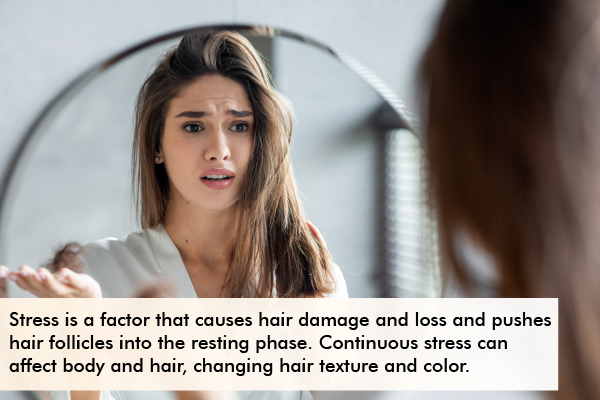
Mast cells regulate the hair follicle’s response to damage and stress. (18) Stress is a factor that causes hair damage and loss (19) and pushes hair follicles into the resting phase.
Continuous stress periods can affect your body and hair, changing your hair texture and color.
How to avoid overstressed hair damage:
- Gently wash, dry, and brush your hair.
- Don’t skip meals when stressed, as it affects your hair.
- A healthy diet provides healthy nutrients to hair when going through stressful periods.
Signs of Hair Damage
The following signs indicate hair damage:
- Rough texture: Hair damage can easily be identified through hair texture. Observe your hair closely by holding it up and running your fingers through it. If it feels rough and sticks out, you have damaged hair.
- Dull hair: If your hair is dull with missing shine and luster, damage has occurred in the hair shaft cuticles. If your hair doesn’t shine even after deep conditioning treatment, it also means it is damaged.
- Split ends: Split ends are the most common type of hair damage where your hair ends split into two or more. They occur when the protective cuticle at the distal hair shaft is lost and the exposed cortex splits. (20)
- Dry hair: Dry hair may not always be damaged, but damaged hair is always dry. Damaged hair remains dry even after moisturizing and conditioning. Dry hair is associated with temporary segment breaks. (21)
- High porosity: Damage to the hair shaft cuticles leads to swollen and frizzy hair due to moisture exposure. Hair is porous, but damaged hair is intensely porous. (21) The porous structure of the cortex and medulla in hair fiber can cause light scattering and affect hair luster and color. The important factors for hair appearance are the alignment of multiple hair fibers, appropriate cross-sectional shape, ordered scaly structure, and pore-less internal structure. (22)
- Excessive hair breakage: If the slightest hair tugs are causing breakage, such as when combing or running your fingers through hair, your hair has been damaged for quite some time. (23)
- Lack of elasticity: The hair has a specific degree of elasticity. But if your hair snaps while stretching, your hair’s elasticity is lost, indicating hair damage.
What Are the Causes of Hair Damage?
Chemical causes of hair damage are hair dyeing, bleaching, and perming. Frequent chemical usage is a primary cause of damaged hair shafts.
Regular or incorrect usage of cosmetic products may change the hair texture, which could change the hair surface morphologically.
Physical causes are induced by friction (due to washing, hair accessories, and towel drying) on the hair surface, particularly wet hair. Other factors include daily grooming and photodamage.
UV exposure damages the hair fibers, causing rough surface texture, increased brittleness, and stiffness, decreased luster and color, and dryness. (24)
Nutritional causes include deficiencies in vitamins and minerals, such as vitamins A, B, C, D, and E, zinc, selenium, and iron, leading to hair damage, dryness, dullness, and loss. (25)
General Queries
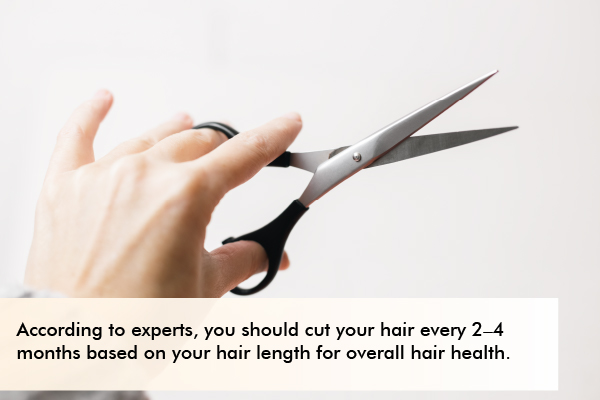
How often should I cut my hair to avoid damage?
According to experts, you should cut your hair every 2–4 months based on your hair length for overall hair health. In the UK, males visit barber shops every 2.5 weeks on average. (26)
How often should I wash damaged hair?
Wash your hair every 3 days with a sulfate-free, gentle shampoo if your hair is damaged due to heat or chemical treatments.
Final Word
Keeping your hair healthy can be challenging as several factors can it. But knowing what damages your hair can give you a way to prevent and repair damaged hair.
So, establish a proper hair care routine so you can wear your hair like a crown!
References
- How to stop damaging your hair. American Academy of Dermatology. https://www.aad.org/public/diseases/hair-loss/insider/stop-damage.
- Kaushik V, Chogale R, Mhaskar S. Alternative protocol for hair damage assessment and comparison of hair care treatments. International journal of trichology. https://www.ncbi.nlm.nih.gov/pmc/articles/PMC7276157/. Published 2020.
- Luqman MW, Ramzan MH, Javaid U, Ali R, Shoaib M, Luqman MA. To evaluate and compare changes in baseline strength of hairs after treating them with deionized water and hard water and its role in hair breakage. International journal of trichology. https://www.ncbi.nlm.nih.gov/pmc/articles/PMC6028999/. Published 2018.
- (PDF) the optimal holding solution and temperature for … – researchgate. https://www.researchgate.net/publication/269709760/.
- (PDF) preparation of sustainable fibers from isosorbide: Merits over … https://www.researchgate.net/publication/345544113/.
- Tinoco A, Gonçalves J, Silva C, Cavaco-Paulo A, Ribeiro A. Crystallin fusion proteins improve the thermal properties of hair. Frontiers in bioengineering and biotechnology. https://www.ncbi.nlm.nih.gov/pmc/articles/PMC6823552/. Published October 25, 2019.
- Lee Y; Kim YD; Hyun HJ; Pi LQ; Jin X; Lee WS; Hair shaft damage from heat and drying time of hair dryer. Annals of dermatology. https://pubmed.ncbi.nlm.nih.gov/22148012/.
- Grosvenor AJ; Deb-Choudhury S; Middlewood PG; Thomas A; Lee E; Vernon JA; Woods JL; Taylor C; Bell FI; Clerens S; The physical and chemical disruption of human hair after bleaching – studies by transmission electron microscopy and redox proteomics. International journal of cosmetic science. https://pubmed.ncbi.nlm.nih.gov/30229956/.
- ZD; D. The biology of hair care. Dermatologic clinics. https://pubmed.ncbi.nlm.nih.gov/11059373/.
- Qu W; Guo X; Xu G; Zou S; Wu Y; Hu C; Chang K; Wang J; Improving the mechanical properties of damaged hair using low-molecular weight hyaluronate. Molecules (Basel, Switzerland). https://pubmed.ncbi.nlm.nih.gov/36431803/.
- Dias MFRG, Loures AF, Ekelem C. Hair cosmetics for the hair loss patient. Indian journal of plastic surgery: official publication of the Association of Plastic Surgeons of India. https://www.ncbi.nlm.nih.gov/pmc/articles/PMC8719955/. Published December 27, 2021.
- Camacho-Bragado GA; Balooch G; Dixon-Parks F; Porter C; Bryant H; Understanding breakage in curly hair. The British journal of dermatology. https://pubmed.ncbi.nlm.nih.gov/26207659/.
- Malkani RH, Shirolikar SM, Karmakar S, Setia MS. Hair styling procedures and hair morphology: A Clinico-microscopic comparison study. Indian dermatology online journal. https://www.ncbi.nlm.nih.gov/pmc/articles/PMC7413455/. Published July 13, 2020.
- Monselise A, Cohen DE, Wanser R, Shapiro J. What ages hair? International journal of women’s dermatology. https://www.ncbi.nlm.nih.gov/pmc/articles/PMC5419032/. Published February 16, 2017.
- Luqman MW; Ali R; Khan Z; Ramzan MH; Hanan F; Javaid U; Effect of topical application of hard water in weakening of hair in men. JPMA. The Journal of the Pakistan Medical Association. https://pubmed.ncbi.nlm.nih.gov/27654734/.
- Sebetić K; Sjerobabski Masnec I; Cavka V; Biljan D; Krolo I; UV damage of the hair. Collegium antropologicum. https://pubmed.ncbi.nlm.nih.gov/19138021/.
- ZD; D. Sunscreens and hair photoprotection. Dermatologic clinics. https://pubmed.ncbi.nlm.nih.gov/16311170/.
- Botchkarev VA. Stress and the hair follicle: Exploring the connections. The American journal of pathology. https://www.ncbi.nlm.nih.gov/pmc/articles/PMC1868107/. Published March 2003.
- Stress and the hair follicle: Exploring the connections – researchgate. https://www.researchgate.net/publication/10890665/.
- Draelos ZD. Essentials of hair care often neglected: Hair cleansing. International journal of trichology. https://www.ncbi.nlm.nih.gov/pmc/articles/PMC3002407/. Published January 2010.
- Gavazzoni Dias MFR. Hair cosmetics: An overview. International journal of trichology. https://www.ncbi.nlm.nih.gov/pmc/articles/PMC4387693/. Published 2015.
- (PDF) hair structures affecting hair appearance – researchgate. https://www.researchgate.net/publication/334411518/.
- Mhaskar S; Kalghatgi B; Chavan M; Rout S; Gode V; Hair breakage index: An alternative tool for damage assessment of human hair. Journal of cosmetic science. https://pubmed.ncbi.nlm.nih.gov/21635848/.
- Lee Y, Kim Y-D, Hyun H-J, Pi L-Q, Jin X, Lee W-S. Hair shaft damage from heat and drying time of hair dryer. Annals of dermatology. https://www.ncbi.nlm.nih.gov/pmc/articles/PMC3229938/. Published November 2011.
- Almohanna HM, Ahmed AA, Tsatalis JP, Tosti A. The role of vitamins and minerals in hair loss: A Review. Dermatology and therapy. https://www.ncbi.nlm.nih.gov/pmc/articles/PMC6380979/. Published March 2019.
- Is having a haircut good for Your Mental Health? – researchgate. https://www.researchgate.net/publication/312067839/.


